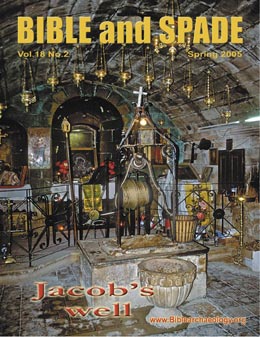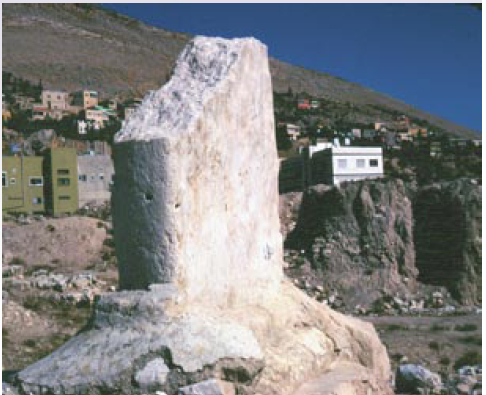
This article was first published in the Spring 2005 issue of Bible and Spade.
Temple of Baal-berith references to the “temple of Baal-Berith” (v. 4), “Beth-Millo” (vv. 6, 20), “temple of their god” (v. 27), “tower of Shechem” (vv.46, 49) and “temple of El-Berith” (v. 46) all appear to be the same structure at Shechem (Stager 2003; 1999: 242, 245; Toombs 1992:1184; Campbell 1983: 269; Campbell and Ross 1963: 16). Berith is the Hebrew word for covenant, so the temple was for “Baal of the covenant.” A large fortress temple discovered on the acropolis of Shechem has been identified as the temple of Judges 9 (Stager 2003; 1999). It was constructed in the 17th century BC and lasted until the destruction of the city by Abimelech in the 12th century BC. The largest temple yet found in Canaan, it measures 70 x 86.3 ft (21.2 x 26.3 m), and has foundations 17 ft (5.1 m) thick that supported a multistoried superstructure of mud bricks and timber.

Massebah, or “standing stone” in front of the fortress temple at Shechem. This may be the stone that Joshua erected at Shechem (Jos 24:26) and the “pillar” where Abimelech was made king (Jgs 9:6).
On the east, two towers containing stairwells to the upper stories flanked the entrance. Inside, two rows of columns, three in each row, divided the space into a nave and two side aisles (cf. vv. 46–49; Stager 2003: 29–31; 1999: 229, 243–45). In front of the temple was a courtyard with a large earthen and stone altar, 7.2 x 5.4 ft (2.2 x 1.65 m) and 1.1 ft (35 cm) high, 21 ft (6.5 m) from the temple entrance. An enormous limestone stela, or massebah, stood 6.6 ft (2 m) further to the southeast. It is 4.8 ft (1.48 m) wide, 1.4 ft (42 cm) thick, and, although broken, 4.8 ft (1.45 m) high. Since the temple existed in Joshua’s day, it is possible this was the “large stone” which he set up “under the oak near the holy place of the Lord” at Shechem (Jos 24:26; Stager 2003: 68; 1999: 242; Campbell and Ross 1963: 11). The stela is undoubtedly the “pillar” where Abimelech was made king (v. 6; Stager 2003: 31, 33; 1999: 242; Campbell and Ross 1963: 11).

East Gate at Shechem where Zebal and Gaal watched Abimelech’s forces advance on the city as dawn was breaking (Jgs 9:345–40). One entered the gate from a cobbled street that ran along the city wall (left side of photo), through the gate and down five steps into the city.
East Gate
The city gate where Gaal, the leader of the opposition force, and Zebal, governor of Shechem, observed the approach of Abimelech’s forces (vv. 34–40) was excavated on the east side of the site (Seger 1997: 22; Toombs 1992; Boling 1975: 179; Wright 1965: 71–76; Campbell and Ross 1963: 16). Facing the agricultural fields to the east, it is a two-entryway gate with a paved courtyard 26.2 x 21.5 ft (8.0 x 6.55 m) between the two entryways. On either side of the courtyard are guardrooms with stairways leading to upper stories.
To enter, one approached from the south along a cobbled street, turned left, and passed through the two entryways 11 ft (3.4 m) wide, ca. 21 ft (6.5 m) apart.

Plan of the fortress temple at Shechem, showing the locations of the altar and standing stones (Hebrew, masseboth) in the courtyard in front.
Destruction Level
Abimelech “destroyed the city and scattered salt over it” (v. 45). Abundant evidence was found throughout the site that a violent destruction had occurred at the time of Abimelech (Seger 1997: 22; Toombs 1993: 1347; 1992: 1178,1184; 1979: 70, 71, 72, 73, 78; 1976:58, 59; 1972: 106; Wright 1967: 364; 1965: 101–102). Lawrence Toombs, one of the excavators of Shechem, described the devastation as follows (1979: 73): The Iron I city underwent violent destruction, which obliterated its buildings and left the site a wilderness of ruins. At the time of its destruction, the culture of the city was fully developed Iron I. The end of the Iron I city is almost certainly to be attributed to its capture by Abimelech (Judges 9).
The excavators date the destruction to ca. 1125–1100 BC (Campbell 1993: 1352; Seger 1997: 22), in excellent agreement with the Biblical time frame. The site then lay abandoned for some 100 years until it was rebuilt in the tenth century BC, the time of the United Monarchy.
Recommended Resources for Further Study
Footnotes
1) The Hebrew word used in Judges 9 for the rulers of Shechem, baal, is used in a similar way in the Amarna Letters for city leaders, ca. 1350 BC (Moran 1992:175, n. 5).
Bibliography
Boling, Robert G.
1975 Judges. The Anchor Bible 6A, Garden City NY: Doubleday.
Campbell, Edward F., Jr.
1983 Judges 9 and Biblical Archaeology. Pp. 263–71 in The Word of the Lord Shall Go Forth: Essays in Honor of David Noel Freedman in Celebration of His Sixtieth Birthday, eds. Carol L. Meyers and Michael O’Connor. Winona Lake IN: Eisenbrauns.
1993 Shechem, Tell Balâtah. Pp. 1345–54 in The New Encyclopedia of Archaeological Excavations in the Holy Land 4, ed. Ephraim Stern. Jerusalem: The Israel Exploration Society Carta.
Campbell, Edward F., Jr., and Ross, James F.
1963 The Excavation of Shechem and the Biblical Tradition. Biblical Archaeologist 26: 1–27.
Moran, William L. 1992 The Amarna Letters. Baltimore: The Johns Hopkins University Press.
Seger, Joe D. 1997 Shechem. Pp. 19–23 in The Oxford Encyclopedia of Archaeology in the Near East 5, ed. Eric M. Meyers. New York: Oxford University Press.
Stager, Lawrence E.
1999 The Fortress-Temple at Shechem and the “House of El, Lord of the Covenant.” Pp. 228–49 in Realia Dei: Essays in Archaeology and Biblical Interpretation in Honor of Edward F. Campbell, Jr., at His Retirement, eds. Prescott H. Williams and Theodore Hiebert. Atlanta: Scholars.
2003 The Shechem Temple Where Abimelech Massacred a Thousand. Biblical Archaeology Review 29.4: 26–35, 66, 68–69.
Toombs, Lawrence E.
1972 The Stratigraphy of Tell Balatah (Ancient Shechem). Annual of the Department of Antiquities of Jordan 17: 99–110.
1976 The Stratifi cation of Tell Balâtah (Shechem). Bulletin of the American Schools of Oriental Research 223: 57–59.
1979 Shechem: Problems of the Early Israelite Era. Pp. 69–83 in Symposia: Celebrating the Seventy-Fifth Anniversary of the Founding of the American Schools of Oriental Research (1900–1975), ed. Frank M. Cross. Cambridge MA: American Schools of Oriental Research.
1992 Shechem (Place). Pp. 1174–86 in The Anchor Bible Dictionary 5, ed. David N. Freedman. New York: Doubleday.
Wood, Bryant G.
1997 The Role of Shechem in the Conquest of Canaan. Pp. 245–56 in To Understand the Scriptures: Essays in Honor of William H. Shea, ed. David Merling. Berrien Springs MI: The Institute of Archaeology/Siegfried H. Horn Archaeological Museum.
Wright, G. Ernest
1965 Shechem: The Biography of a Biblical City. London: Gerald Duckworth.
1967 Shechem. Pp. 355–70 in Archaeology and Old Testament Study, ed. D. Winton Thomas. Oxford, England: Clarendon.